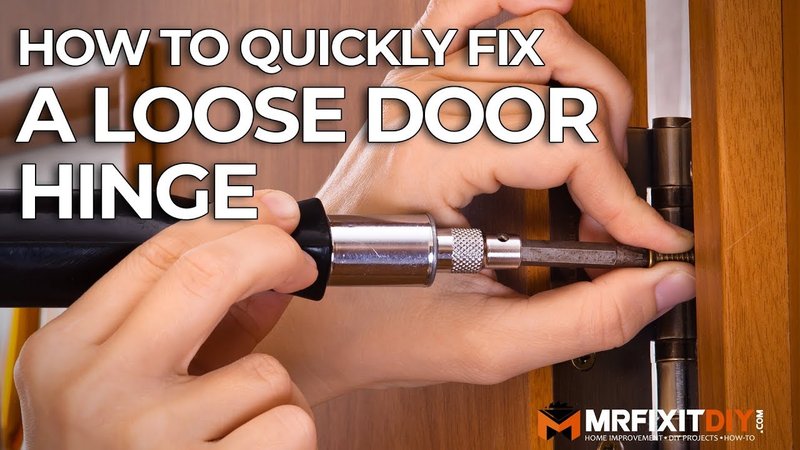
In this article, we’ll explore the steps you can take to fix a loose or wobbly door hinge. From simple fixes, like tightening screws, to more involved solutions, like replacing the hinge, I’ll guide you through the process in a straightforward, beginner-friendly way. So, grab your tools, and let’s get started!
Understanding Why Your Door Hinge Is Loose
You might be wondering, “How did my door hinge end up loose in the first place?” Several factors can contribute to a wobbly door hinge. Over time, the screws may have come loose due to regular wear and tear. If you have a heavy door, or if the door was hung improperly, it might put additional stress on the hinges.
Sometimes, changes in temperature and humidity can also play a role. Wood doors can expand and contract, affecting how well the hinge fits. Imagine a rubber band stretching—eventually, it might lose its shape and not hold things together as tightly as it once did. If you’ve noticed a shift in how your door closes or opens, it’s likely time to check those hinges!
Check the Screws: Tightening is Key
One of the easiest and most straightforward solutions is simply tightening the screws on the door hinge. Before you break out the toolbox, grab a screwdriver and give it a try. Here’s how you can do it:
- Check for any visible loose screws on the hinge.
- Use a screwdriver to tighten them. Make sure you don’t over-tighten, as this can strip the screws.
- If the screw holes are stripped, you might consider using longer screws for a more secure fit.
If you notice that the screws are still loose after tightening, it may be time for a different approach. But don’t worry, you’ve got options!
Adding Wood Filler or Toothpicks
If tightening doesn’t do the trick, wood filler or toothpicks can help. This is especially useful if the screw holes are damaged or stripped—a bit like putting a band-aid on a scrape. Here’s what you do:
1. Remove the loose screws.
2. Insert wooden toothpicks or apply wood filler into the holes.
3. Reinsert the screws once the wood filler has dried or the toothpicks are securely in place.
This method provides a more solid base for the screws, making the hinge feel snug once again. Just think of it as giving your hinge a little extra support, like adding a brace to a weak limb.
Replacing the Hinge: When is it Necessary?
If you’ve tried tightening and adding filler, but the hinge still feels shaky, it might be time for a replacement. Replacing a door hinge isn’t as daunting as it sounds. You’ll just need a few tools and a new hinge. Here’s a simple step-by-step:
- Remove the door from its frame by unscrewing the hinges.
- Take the old hinge to a hardware store to find an exact match.
- Install the new hinge by following the same steps in reverse.
Replacing a hinge can provide a fresh start for your door, kind of like how a new pair of shoes can make your feet feel better when the old ones are worn out. If you’re unsure about the size or type of hinge, don’t hesitate to ask a store associate for help!
Lubricating Your Hinges: Keep Things Running Smoothly
Sometimes, a loose hinge isn’t just about being wobbly; it may also squeak or grind when you open the door. In these cases, a little lubrication can work wonders. Just like oiling a rusty bike chain, a well-lubricated hinge can function smoothly and quietly.
To lubricate your hinges:
1. Choose a lubricant. A silicone spray or even some household oils, like WD-40, works well.
2. Apply a small amount on the hinge pivot points.
3. Open and close the door a few times to let it work its magic.
With a few spritzes, your door can start behaving as if it’s brand new! Keeping the hinges lubricated can help prevent future issues, so it’s a good habit to adopt.
Assessing Door Alignment: Is it Time for Adjustments?
If your door isn’t closing properly or seems misaligned, it may not be just the hinge causing the problem. Misalignment can cause stress on the hinges, leading to looseness over time. You might notice gaps or resistance when closing the door.
To check for alignment issues:
1. Look closely at how the door sits in the frame. Does it seem off to one side?
2. Adjust the hinges by loosening them slightly, repositioning the door, and tightening them back up.
Taking these steps can restore your door’s alignment, making it easier to operate without straining those hinges. Think of it as realigning a picture frame—you want everything to be perfectly centered.
Preventing Future Problems: Maintenance Tips
Now that we’ve tackled the main issues, let’s talk about prevention. Regular maintenance can go a long way in keeping your door and hinges in top shape. Here are some simple tips:
- Check your hinges periodically for any signs of wear.
- Tighten screws as needed before they become a bigger problem.
- Lubricate your hinges at least once a year.
By making a habit out of this simple maintenance, you’ll prevent many common issues that can arise. It’s like keeping your car’s oil changed regularly—you can save yourself from unexpected troubles down the road.
When to Call a Professional
Sometimes, despite your best efforts, things just don’t work out. If you find yourself struggling with repairs or worrying about doing more harm than good, it might be time to call a professional. A handyman can quickly identify the problem and offer solutions you might not have considered.
Hiring a pro doesn’t mean you’re giving up; it’s just being smart about your time and resources. Plus, it can save you a lot of headache in the long run.
In conclusion, dealing with a loose or wobbly door hinge doesn’t have to be a dreaded task. Whether you choose to tighten screws, use wood filler, or even replace the hinge, you now have several options at your disposal. Just take it step by step, and don’t hesitate to seek help if needed. With a little effort, you can have that door swinging smoothly in no time!
